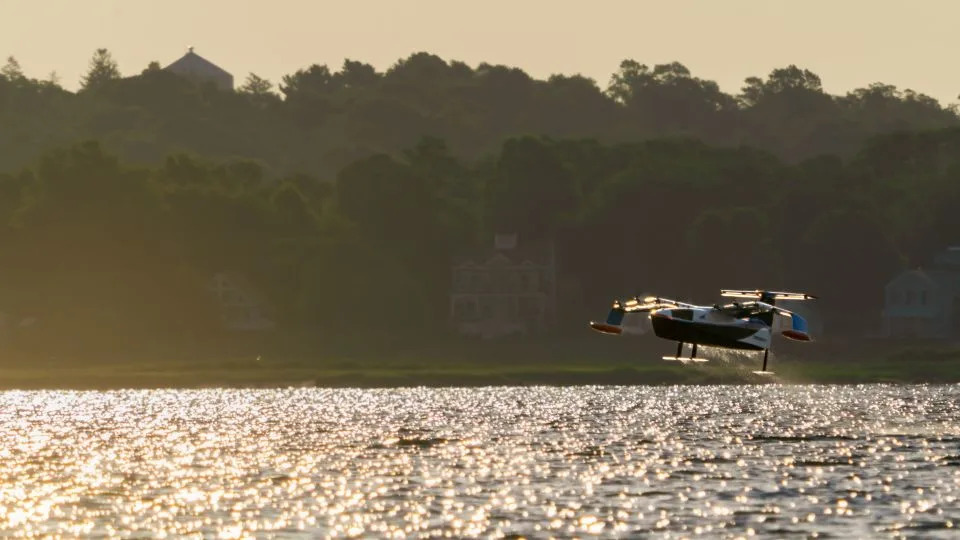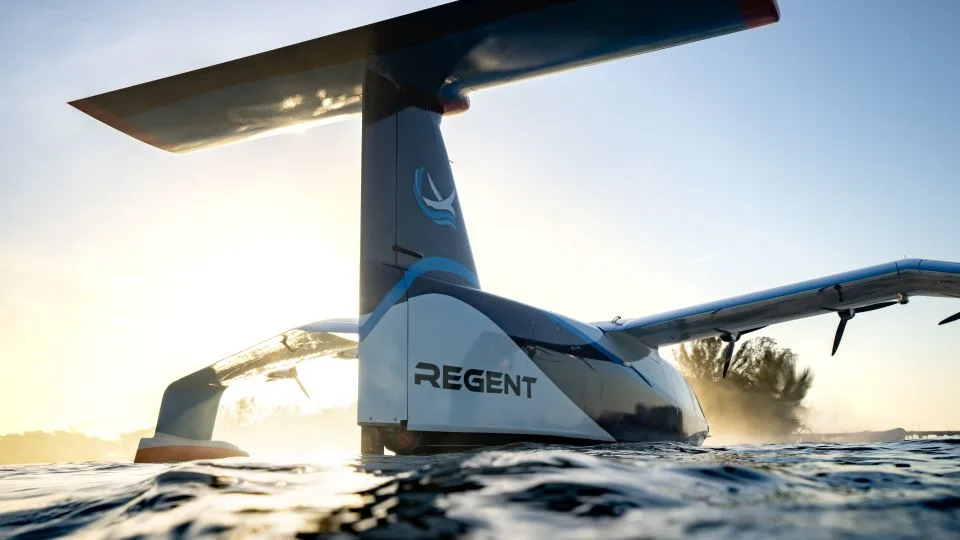Jacopo Prisco, CNN
Wed, June 12, 2024
Editor’s Note: This CNN series is, or was, sponsored by the country it highlights. CNN retains full editorial control over subject matter, reporting and frequency of the articles and videos within the sponsorship, in compliance with our policy.
You might be used to take-offs and landings, but you soon might need to get ready to “float, foil and fly.”
Those are the three phases of a journey aboard a seaglider, a new type of fully electric boat-plane hybrid that could become a mainstay of coastal communities the world over, according to its maker, Boston-based startup REGENT.
Just like a boat, a seaglider initially floats, then as it picks up speed it foils — gliding over the surface of the water using wing-like structures called hydrofoils, which retract as the vehicle finally takes off for the flying phase. It never reaches the sky, but rather flies up to 30 feet (nine metres) above the water, to leverage a principle called “ground effect,” which promises a smooth ride with reduced drag compared to a normal flight.
“We’re going to put humans on board a full-scale, 15,000-pound (6,800-kilogram) prototype later this year,” says Billy Thalheimer, co-founder and CEO of REGENT, adding that the first seagliders will carry up to 12 passengers and will have a range of about 180 miles (290 kilometers), which would put them in direct competition with small ferries and seaplanes.
More than 600 seagliders have already been sold for a total of over $9 billion, according to Thalheimer. The vehicles will be manufactured in North America, but REGENT recently signed a deal with the government of Abu Dhabi to build a second plant in the United Arab Emirates, to serve clients in the region and across Europe and Asia.
Once operational, seagliders will then connect Abu Dhabi to Dubai, as well as island communities that are currently underserved by existing services.
“We want to prove to the world that this is possible,” says Thalheimer, “specifically that in one vehicle you can float, foil and fly.”

A prototype of a seaglider taking flight - Regent
A classic concept
The “ground effect” principle that the seagliders use isn’t new; it was extensively tested by the Soviet Union in the 1960s, leading to some prominent examples of “ekranoplans” — large planes designed to fly at low altitude over water, ice or land — the most famous of which is the “Caspian Sea Monster.”
“Technically, everything that flies leverages the ground effect during take-off and landing, so everyone has experienced it — they just don’t really realize it,” explains Thalheimer. “When you’re coming in on a bumpy approach, then sort of get right over the runway, and the plane just sort of floats for a second before landing — that’s the ground effect at work. Wouldn’t that be a great place to spend the entire flight, that nice calm state over the runway?”
The United States and Germany also experimented with ground effect vehicles, but ultimately the concept never took off. For the seagliders, the reduced drag allows for more range with existing battery technology, and smoothes the transition with the other phases of the journey, in the harbor, that are more akin to sailing than flying.
To create a modern and viable ground-effect vessel, REGENT had to solve several problems. First, Thalheimer says, seagliders are better at dealing with waves than vintage ekranoplans. “These things were skipping off the sea surface. At best, they were uncomfortable and really bumpy. At worst, you couldn’t operate them at all. We solved the wave tolerance problem with the hydrofoils,” he says, with full-scale seagliders able to tolerate waves up to five feet high.
The second challenge was maneuverability in a harbor; because ekranoplans didn’t have any waterborne steering mechanism, they were unsafe in a crowded harbor environment. The hydrofoils help, as do the three modes of operation. “Rather than going directly from floating to flying, we have this intermediate mode, foil. That foiling mode allows us to get through the harbor, it allows us to be a boat where it makes sense to be a boat,” he says. “And then once we get into the open water, where the traffic is truly dispersed, that’s when we take off onto the wing and settle into the ground effect.”
The last improvement is about safety, Thalheimer says. Old ground effect vehicles were more akin to aircraft, with pilots controlling them at all times. “From the pilot’s point of view that’s basically like landing a plane for the entire time you’re flying it — too mentally demanding. But now we have these incredible flight control sensors and software systems that let humans do what humans are good at, which is navigating, communicating, planning, and strategizing. We’re going to let the vessel fly itself and the only thing that the captain is doing now is boat controls: left and right, fast and slow. It’s a highly automated system that is still controlled by a human pilot.”

Seagliders are technically maritime vessels, which REGENT says will speed up certification and entry into service. - Regent
The “ground effect” principle that the seagliders use isn’t new; it was extensively tested by the Soviet Union in the 1960s, leading to some prominent examples of “ekranoplans” — large planes designed to fly at low altitude over water, ice or land — the most famous of which is the “Caspian Sea Monster.”
“Technically, everything that flies leverages the ground effect during take-off and landing, so everyone has experienced it — they just don’t really realize it,” explains Thalheimer. “When you’re coming in on a bumpy approach, then sort of get right over the runway, and the plane just sort of floats for a second before landing — that’s the ground effect at work. Wouldn’t that be a great place to spend the entire flight, that nice calm state over the runway?”
The United States and Germany also experimented with ground effect vehicles, but ultimately the concept never took off. For the seagliders, the reduced drag allows for more range with existing battery technology, and smoothes the transition with the other phases of the journey, in the harbor, that are more akin to sailing than flying.
To create a modern and viable ground-effect vessel, REGENT had to solve several problems. First, Thalheimer says, seagliders are better at dealing with waves than vintage ekranoplans. “These things were skipping off the sea surface. At best, they were uncomfortable and really bumpy. At worst, you couldn’t operate them at all. We solved the wave tolerance problem with the hydrofoils,” he says, with full-scale seagliders able to tolerate waves up to five feet high.
The second challenge was maneuverability in a harbor; because ekranoplans didn’t have any waterborne steering mechanism, they were unsafe in a crowded harbor environment. The hydrofoils help, as do the three modes of operation. “Rather than going directly from floating to flying, we have this intermediate mode, foil. That foiling mode allows us to get through the harbor, it allows us to be a boat where it makes sense to be a boat,” he says. “And then once we get into the open water, where the traffic is truly dispersed, that’s when we take off onto the wing and settle into the ground effect.”
The last improvement is about safety, Thalheimer says. Old ground effect vehicles were more akin to aircraft, with pilots controlling them at all times. “From the pilot’s point of view that’s basically like landing a plane for the entire time you’re flying it — too mentally demanding. But now we have these incredible flight control sensors and software systems that let humans do what humans are good at, which is navigating, communicating, planning, and strategizing. We’re going to let the vessel fly itself and the only thing that the captain is doing now is boat controls: left and right, fast and slow. It’s a highly automated system that is still controlled by a human pilot.”

Seagliders are technically maritime vessels, which REGENT says will speed up certification and entry into service. - Regent
Island hopping
In the summer of 2022, REGENT tested a quarter-scale prototype of its seaglider — a remotely operated version weighing 400 pounds, with a wingspan of 18 feet. The full-scale commercial vehicle, named Viceroy, will have a wingspan of 65 feet and fly between 20 and 30 feet off the sea surface
Among the first customers to operate seagliders, Thalheimer says, will be Surf Air Mobility, a commuter airline that will use the vehicles to connect islands in Hawaii, and along the coastline of Miami, through Key West and out to the Bahamas. In Europe, Brittany Ferries has long expressed interest in the seagliders to connect the UK and France across the English Channel, and Thalheimer says deals are in place across the Mediterranean to connect the South of France and Italy, as well as the Greek islands. Japan Airlines and New Zealand startup Ocean Flyer will also be among the first operators, Thalheimer adds.
In Abu Dhabi, the seagliders will not just support tourism operations, but existing public transport bottlenecks. “Specifically, the Abu Dhabi Department of Transport is looking to increase connections to more distant emirates like Ras Al Khaimah, which are many hours away by car today, as well as underserviced Island communities in the Gulf, like Dalma Island,” he says. “We’re actually seeing this kind of model apply to many other island communities around the world.”
100 passengers?
Once Viceroy is up and running, REGENT plans to put into service an even bigger seaglider, called Monarch, which will have capacity for up to 100 passengers and, Thalheimer says, will enter service at the end of the decade. However, he adds, an improvement in battery technology would be required to support the hypothetical vehicles’ projected range of 300 to 500 miles.
According to Darren Biddlecombe, head of data at aviation consultancy firm AviationValues, REGENT’s plan is possible from a technological standpoint. “However, there are also regulatory and commercial barriers to bringing a new product to any market, and further challenges to becoming financially sustainable. Regent’s ability to turn its order book into actual deliveries will depend largely on how well it can attract — and retain — the necessary capital and expertise to overcome those challenges,” he says.
A potentially convenient and environmentally friendly form of travel certainly looks to be an interesting prospect, Biddlecombe adds, but it will come down to REGENT’s ability to produce and support the vehicles in such a way that operators can use them safely, reliably and at a cost that passengers are willing to pay. “That goes well beyond the vessels themselves to the training, infrastructure, parts and maintenance support, and regulatory approval,” he says. “If REGENT can navigate those waters, they may well have a shot.”
For more CNN news and newsletters create an account at CNN.com
No comments:
Post a Comment